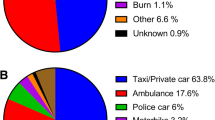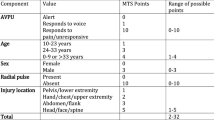Abstract
Background
Trauma scoring systems have been developed to assess injury severity and may have triage potential. We sought to evaluate the ability of the Kampala trauma score (KTS) to assess injury severity and its potential as an outcome predictive tool in Malawi.
Methods
This is a prospective cohort study of trauma patients presenting to Kamuzu Central Hospital in 2012. We recorded admission KTS and Revised trauma score (RTS), emergency department disposition, and hospital length of stay (LOS) and survival. Logistic regression and ROC curve analyses were used to compare the KTS to the widely accepted RTS.
Results
15,617 patients presented with trauma. 2,884 (18 %) were admitted, of which 2,509 (95 %) survived. The mean admission KTS was 14.5 ± 0.6, and RTS was 11.9 ± 0.3. For KTS and RTS, the odds of admission with each increment increase in score was 0.44 and 0.3, respectively. Similarly, odds of mortality is 0.48 and 0.36. Neither KTS (p = 0.96, ROC area 0.5) nor RTS (p = 0.25, ROC area 0.5) correlated significantly with hospital LOS. KTS and RTS performed equally well as predictors of mortality, but KTS was a better predictor of need for admission (KTS ROC area 0.62, RTS ROC area 0.55, p < 0.001).
Conclusions
Both the KTS and RTS were significantly associated with need for admission and final outcome on logistic regression analysis; however, they may not be strong enough predictors to merit their use as a screening tool in our setting.


Similar content being viewed by others
References
World Health Organization (WHO) (2002) World report on violence and health. WHO, Geneva
Berger L, Mohan D (1996) Injury Control: A Global View. Oxford University Press, New York
World Health Organization (WHO) (2010) Injuries and violence: the facts. WHO, Switzerland
Mathers CD, Sadana R, Salomon JA et al (2001) Healthy Life Expectancy in 191 Countries, 1999. Lancet 357:1685–1691
World Health Organization (WHO) (2002) The Injury Chart Book. Geneva, Switzerland. Available at whqlibdoc.who.int/publications/924156220x.pdf. Accessed 5 April 2014
World Health Organization (WHO) (2006) The World Health Report 2006: working together for health. Geneva. Available at http://www.who.int/whr/2006/whr06_en.pdf?ua=1. Accessed 5 April 2014
World Health Organization (WHO) WHO Africa region: Malawi statistics summary (2002 to present). Available at http://apps.who.int/gho/data/?theme=country&vid=12800. Accessed 5 April 2014
World Health Organization (WHO) Noncommunible diseases country profiles 2011. Available at http://www.who.int/nmh/countries/mwi_en.pdf?ua=1. Accessed 5 April 2014
Baker S, O’Neill B, Haddon W et al (1974) The injury severity score: a method for describing patients with multiple injuries and evaluating emergency care. J Trauma 14:187–196
Boyd C, Tolson M, Copes W (1987) Evaluating trauma care: the TRISS method. J Trauma 27:370–378
Champion H, Sacco W (1989) A revision of the trauma score. J Trauma 29:623–629
Kingston R, O’Flanagan SJ (2000) Scoring systems in trauma. Ir J Med Sci 169(3):168–172
Kobusingye OC, Lett RR (2000) Hospital-based trauma registries in Uganda. J Trauma 48(3):498–502
MacLeod JBA, Kobusingye O, Frost C et al (2003) A comparison of the kampala trauma score (KTS) with the revised trauma score (RTS), injury severity score (ISS) and the TRISS method in a Ugandan trauma registry: is equal performance achieved with fewer resources? Eur J Trauma 29(6):392–398
Samuel JC, Akinkuotu A, Baloyi P et al (2010) Hospital-based injury data in Malawi: strategies for data collection and feasibility of trauma scoring tools. Trop Doctor 40(2):98–99
Chalya PL, Mabula JB, Dass RM et al (2012) Injury characteristics and outcome of road traffic crash victims at Bugando Medical Center in Northwestern Tanzania. J Trauma Manag Outcomes 6(1):1
Acknowledgments
The authors wish to thank Jared Tomlinson MD for his help in facilitating data collection. This research was supported by the Doris Duke Charitable Foundation; The UNC Institute of Global Health and Infectious Diseases; the UNC Center for AIDS Research.
Author information
Authors and Affiliations
Corresponding author
Rights and permissions
About this article
Cite this article
Haac, B., Varela, C., Geyer, A. et al. The Utility of the Kampala Trauma Score as a Triage Tool in a Sub-Saharan African Trauma Cohort. World J Surg 39, 356–362 (2015). https://doi.org/10.1007/s00268-014-2830-6
Published:
Issue Date:
DOI: https://doi.org/10.1007/s00268-014-2830-6




